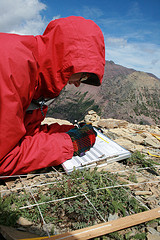Science "home"work for interested students
By Mary Bigelow
Posted on 2015-01-07
 I have several students this year who are really into science. I’d like to provide or suggest some elementary-level projects or activities that parents can do with them at home to encourage this interest. Do you have any ideas beyond book lists and activity sheets? —M. from Maryland
I have several students this year who are really into science. I’d like to provide or suggest some elementary-level projects or activities that parents can do with them at home to encourage this interest. Do you have any ideas beyond book lists and activity sheets? —M. from Maryland
Your desire to foster student interest in science through science activities with their families is commendable. Creating formal projects for this group of students would require time on your part to organize and could be a burden for families in terms of time and resources. But there are many ways to involve students and parents with informal and enjoyable science-related activities.
In your school or class newsletter, website, or blog, include information about free events at local parks, nature centers, libraries, or museums. Encourage students who attend these events to share their experiences and photographs. NSTA’s SciLinks can help you create a list of appropriate websites related to your unit topics that you could share with parents.
Annotate the school or class calendar with prompts for family conversations (What is your first memory of being outdoors? How have inventions and technology changed over the years? Play I Spy at home and find objects made of metal, plastic, glass, wood. Talk about where food comes from.) If you involve other subject areas, every day on the calendar can have a conversation-starter. Encourage children and their parents/caregivers to build with blocks, walk and play outside if possible, grow a garden or even a few house plants, observe a pet’s behavior, or cook together (reinforcing measurement, nutrition). If your students and their parents speak another language at home, it would be helpful to have several versions of your suggestions.
I worked with an elementary school that had take-home “kits” in plastic bags, created by volunteers from a high school service group (backpacks or pizza boxes could also be used to organize the kits). The student- and parent-friendly materials were donated or bought at a dollar store or flea market. For science, these kits included CDs or DVDs with podcasts of science programs, trade books to read at home with suggested discussion questions, small collections (such as leaves, seashells, rocks, or pictures) with directions on sorting or identifying, a plastic ruler and a magnifying glass with some simple directions for observing and collecting data, maps of the night sky for star gazing, an inexpensive pair of binoculars and a field guide on birds, and sets of building blocks. Students signed out a kit to take home, and they were not “graded” on the use of the kits. Of course, some kits never made it back to the classroom, but that didn’t discourage the teachers from continuing the project. A project such as this would require your time or a group of volunteers to create, sign out, inventory, and replenish the kits.
Students could make small journals to take home with suggestions on each page for something to observe, illustrate, and write about (e.g., the weather, phases of the moon, insects, clouds). If you have a class website, students and parents could send photographs or writing to include (you would want to monitor and moderate this process, however, and provide guidelines and examples).
You could suggest citizen-science or collaborative research in which students, parents, and teachers participate in existing projects with science institutions and organizations. SciStarter is a searchable collection of these projects–regional, national, and international. There are projects appropriate for all grade levels and on a variety of topics. It’s a win-win scenario for all involved—the sponsor gets additional observers and data-collectors, parents and their children can work together on them, and the students get experiences that can extend into careers or lifelong learning. Follow SciStarter on Faceboook or Twitter for the latest projects.
Some parents may feel that they don’t have enough background in science, but how you introduce and promote the activities can encourage them to learn with their children. You’re giving “home” work a whole new life!
Additional resources and suggestions from NSTA:
- This Earth Day, Engage Kids in Citizen Science!
- Citizen science: Collaborative projects for teachers and their class
- Community-based science
- Citizen Science: Engaging Students Through Public Collaboration in Scientific Research
- Citizen Science (December 2012, The Science Teacher)
- Community-Based Science (March 2010, Science Scope)
- Getting Families Involved (February 2012, Science & Children)
- Informal science is one of NSTA’s online discussion forums
- Peggy Ashbrook, author of the monthly Early Years Column in Science and Children and the Early Years blog has been an advocate of citizen science for our youngest scientists.
Photo: http://www.flickr.com/photos/glaciernps/4427417055/in/photostream/
Disclaimer: The views expressed in this blog post are those of the author(s) and do not necessarily reflect the official position of the National Science Teaching Association (NSTA).


